American logistics in the Normandy campaign
The Services of Supply (SOS) was formed under the command of Major General John C. H. Lee in May 1942 to provide logistical support to the European Theater of Operations, United States Army.Crucially, the logistical plan called for a one-month pause at the Seine River, which Allied forces were expected to reach 90 days after D-Day, before advancing further.The nature of the fighting in the Normandy bocage country created shortages of certain items, particularly artillery and mortar ammunition, and there were unexpectedly high rates of loss of bazookas, Browning automatic rifles (BARs), and M7 grenade launchers.Planning began in earnest at the ABC-1 Conference in Washington, D.C., in January to March 1941, where agreement was reached with the UK and Canada on a Europe first strategy in the event of the US being forced into a war with both Germany and Japan.On 9 March 1942, Marshall had conducted a sweeping reorganization that consolidated logistical functions in the US under the United States Army Services of Supply (USASOS), headed by Major General Brehon B. Somervell.[7] Marshall and Somervell wanted it led by someone familiar with the new organization, and selected Major General John C. H. Lee, who had previously commanded the Pacific Ports of Embarkation in the United States.Brigadier General Claude N. Thiele, the SOS Chief of Administrative Services, found 500,000 square feet (46,000 m2) of office space in Cheltenham.[16][17] Doubtful that sufficient shipping was available to support both Bolero and Torch, Somervell ordered all construction work in the UK to cease, except on airfields,[17] but the British government went ahead anyway, using materials and labor supplied under Reverse Lend-Lease.[18] Roundup was not carried out, but Bolero survived, strengthened by the decision at the 1943 Washington Conference (codenamed "Trident") to mount the cross-channel attack with a target date of 1 May 1944.They were supplemented by other liners, including the RMS Aquitania and Mauretania, and the SS Île de France, Nieuw Amsterdam and Bergensfjord, which accounted for another 36 percent.This was not accomplished without difficulty; most of the cargo handling equipment was old and outdated, and it was not possible to follow the standard US practice of moving goods from the quayside on pallets with forklifts.SOS ultimately persuaded a reluctant ASF to accept a system whereby every item shipped was individually labelled with a requisition number that provided a complete UK destination address.[25] SOS prevailed upon ASF to implement a system called "prestowage", under which ships were loaded in the United States with blocks of supplies that included rations, equipment and ammunition.[33] The British had already activated the 21st Army Group in July 1943, but several months passed before Devers prevailed on the War Department to authorize American counterparts.In the second stage, which would occur after a lodgment was secured and supply depots began functioning, the system would become semi-automatic, with items like ammunition shipped on the basis of status reports.Crucially, the logistical plan called for a one-month pause at the Seine River, which was expected to be reached by D plus 90, before continuing the advance to the German border.Their name was misleading because, as well as three engineer battalions, each contained amphibious truck and port companies, and quartermaster, ordnance, medical, military police, signals and chemical warfare units.[56] As the infantry advanced, the engineers filled in anti-tank ditches, cleared minefields, demolished obstacles, opened three exits, and established the first supply dumps.If the Germans had sunk a ship it would have been highly embarrassing to the War Department, as no proper embarkation records were kept for a time, and it would not have been possible to notify the next of kin.Major General Leonard T. Gerow, the commander of V Corps, personally returned to the UK to locate a missing unit that the Southern Base Section had claimed had been shipped, but which was found still in its assembly area.[71] The procedure had been performed successfully in the Mediterranean and the Pacific, but with the high tidal range and uneven beaches of Normandy, naval officials feared that the LSTs might break their backs.[64] On 10 June, the First Army ordered the selective discharging of LSTs and Landing Craft, Tank (LCTs) to cease; this was extended to all vessels the following day.The First Army once again imposed strict rationing on 16 July, but expenditure was well below the limits owing to most of the tubes going silent as they moved into new gun positions for Operation Cobra, the attempt to break out from Normandy.The lemon powder in the C- and K-rations was their primary sources of vitamin C, but it was particularly unpopular with the troops, who frequently discarded it, or used it for tasks like scrubbing floors.The jerrican had convenient carrying handles, stacked easily and did not shift or roll in storage, and floated in water when filled with MT80 (80 Octane gasoline).Steady progress was made on construction of the Minor System pipeline, which ran from Port-en-Bessin and Sainte-Honorine-des-Pertes to Saint Lo, and the tank farm at Mont Cauvin received its first bulk MT80 on 25 June.This resulted in larger than anticipated expenditure and shortages of certain items, particularly artillery and mortar ammunition, and calls for the introduction of new model tanks and the upgrading of existing ones.When supplies for the air forces, civil affairs and overheads such as materials for the repair of roads, rehabilitation of ports and construction of pipelines were taken into account, some 26,500 long tons (26,900 t) had to be landed each day.[109] When the Normandy campaign officially ended on 24 July,[110] the lodgment area covered about 1,570 square miles (4,100 km2), about a tenth of what was anticipated, but troops continued to arrive at a rate only slightly less than scheduled.[111] The delay in the capture of Cherbourg meant that the build up of stockpiles had proceeded slower than expected, only about 62 percent of the intended volume of supplies being landed.




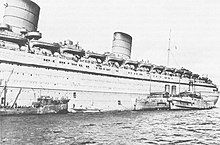


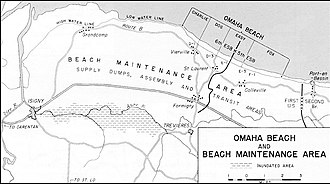


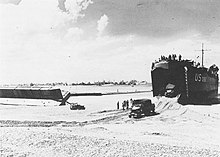
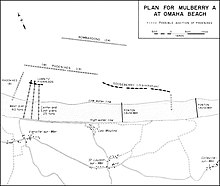
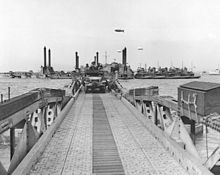




USS LST-21Operation OverlordAtlantic WallBodyguardFortitudeZeppelinTitanicTaxable, Glimmer & Big DrumCombined Bomber OffensivePointblankTransport PlanPostage AbleTarbrushFabiusCaen canal and Orne river bridgesMerville BatteryMallardAmerican SectorAlbanyBostonChicagoDetroitElmiraNormandy landingsPointe du HocGambitPort-en-BessinOperation ChastityBritishMulberryBrécourt ManorGraignesLa Haye-du-PuitsSaint-LôCarentanHill 30CherbourgBrévilleVillers-BocageLe Mesnil-PatryNormandy massacresArdenne AbbeyDouvresMartletWindsorCharnwoodJupiter2nd OdonAtlanticGoodwoodVerrières RidgeSpringBluecoatTotalizeHill 140LüttichTractableHill 262ChamboisFalaiseSaint-MaloMantes-GassicourtLa RochelleUshantLa CainePierres NoiresAudierne BayJedburghDingsonSamwestCooneyBulbasketHoundsworthLoytonKiplingDragoonWallace & HardyCemeteriesAlliedWorld War IIOperation CobraServices of SupplyMajor GeneralJohn C. H. LeeEuropean Theater of Operations, United States ArmyCommunications ZoneOperation BoleroBrittanyQuiberon Baydeveloped as a portSeine RiverAllied forcesFirst United States ArmyUtah BeachesMulberry artificial portlodgmentbocageartillerymortarbazookasBrowning automatic riflesM7 grenade launchersWar Plan BlackABC-1 ConferenceWashington, D.C.Europe firstJames E. ChaneyUnited States Army Air CorpsUS Embassy1 Grosvenor SquareGrosvenor SquareWorld War IIWar DepartmentUnited States Army Forces in the British IslesRainbow 5Chief of Staff of the United States ArmyGeneralGeorge C. MarshallHarry L. HopkinspresidentPrime Minister of the United KingdomChiefs of Staff CommitteeUnited States Army Services of SupplyBrehon B. SomervellWorld War Itheater of war